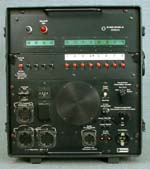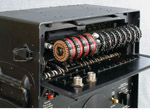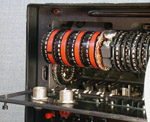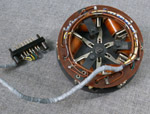All the Gretag crypto devices delivered to the Swiss Army
were fitted with the SPG dial which is an abbreviation for the German term
"Schluessel-Produktions-Geraet," a key production device. It is only a
decoder and has nothing to do with the production of the cryptogramm. The
SPG decodes 5 bits of the cryptogramm to 1 of 32 alphabetic letters (A
- Z; A, E, I, O, U and Y are repeated twice).
What was the purpose of the SPG ?
Each telegramm or transmitting sequence has to be encrypted with
a different key. With the Enigma machine, the operator enciphered
6 letters (a pair of 3 random letters) along with the basic key (Tagesschluessel)
which was known to every station. The result of the ciphering was
a set of 6 letters. They were the first 6 letters of the telegramm. The
telegramm itself was ciphered with the 3 random letters and the ciphering
was appended to the first 6 letters. The other station deciphered first
the 6 letters of the telegramm with the basic key an got the telegramm
key twice. With the telegramm formed, position 7 to the end ot the
message was deciphered with the telegramm key.
A similar method was used with the Gretag devices. The generator
produced a cryptogramm with a length of 26 bits and was a random set. Fourteen
bits are used to cipher or decipher the letters; 12 are used to step the
12 wheels of the generator. Only a 1 in the cryptogramm moves the wheels
one step forward. The SPG decodes bits 1 to 5 of the cryptogramm
and shows as 1 of 32 letters.
How is a key produced?
Station 1 notes a series of 12 random numbers between 1 and 9
(ie 3 5 4 5 9 6 1 8 3 5 7 8) and transmits them in clear to Station
2. Both stations now switch the machine to "key production" mode. The cryptogramm
generator was then set to the basic key. Next, the generator was stepped
3 times (the first number). This action steps the SPG assembly to indicate
a letter. This letter was written down as the first letter by the operator.
Then 5 steps later, the second letter was shown and written down.
This process was repeated to the twelfth number. The net result was a series
of 12 letters which became the individual telegramm key. Used by the Swiss
Army, it took about 10 minutes to produce each new key!
Alternatively, a list with some 100 keys could be used. Each key
series was prefixed with a reference number. Station 1 only had to send
the reference number (in the clear) to use Key Nr.091 as an example. This
was far easier and faster.
To summarize, the SPG is a 5 to 32 decoder. It was used to produce
a telegramm key out of a basic key using a set of 12 random numbers.
The SPG was not involved with the generation of the cryptogramm.
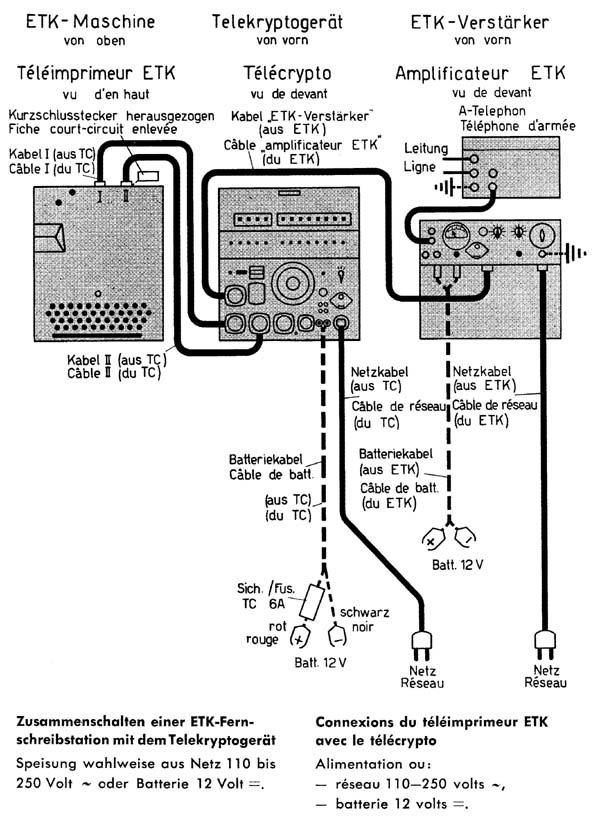 |
| Cabling interconnect diagram between the TC-53 and the
ETK series teletype equipment. The ETK portion consists of two parts,
the ETK-Maschine (teletype device) and the ETK-Verstarker (amplifier with
modulator and demodulator). (Image via Walter Schmid, HB9AIV) |
 |
| 1956: (L-R) Power supply for the transceiver, Zellweger Model SE222
HF transceiver, ETK 47 teletype, TC-53 crypto unit and ETK
47 amplifier (modem). The purpose of this configuration was to test ciphered
transmissions over short wave radio. It did not work. The cryptogram generators
fell out of step very often due to signal fading and interference. After
several tests, it was decided to develop a new device, the KFF 58 which
could be synchronized. (Photo from the collection of Walter Schmid
HB9AIV) |
Zellweger AG SE222 Transceiver Specifications
Frequency range: 1.7 to 3.5 MHz
Modes and power output: CW, SSB and F1 modes
F1= 100 W, A3a =200 W; A1=100 W.
Primary power: 92 - 292 Volt
Production Years: 1956 – 1963
Dimensions (WHD) 420 x 380 x 310 mm / 16.5 x 15 x 12.2 inch
Net weight: 26 kg / 57.3 lb
Comment: About 550 SE222's were delivered to the Swiss Army.
Contributors and Credits:
1) Walter Schmid <hb9aiv(at)swissonline.ch>
2) SE-200
specs

